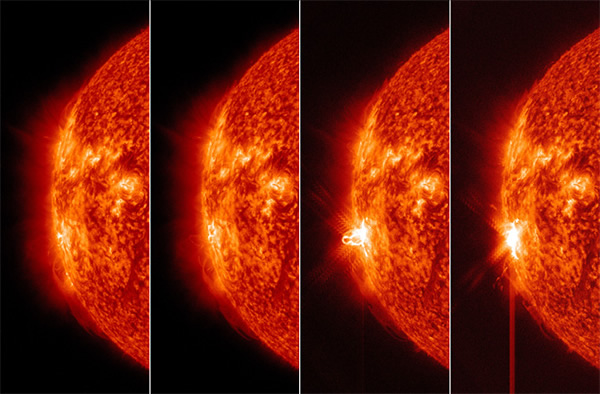Sun Erupts with Huge X-Class Flare, Biggest of 2014
The sun as seen by NASA's Solar Dynamics Observatory in extreme ultraviolet light -- multimillion degree plasma in the lower corona glows bright in the 193A wavelength SDO filter.
Solar maximum may be starting to wane, but the sun has no intention on slipping into the stellar doldrums quietly. At 7:50 p.m. EST on Monday (00:50 UTC, Feb. 25), a sunspot emerging from the southeastern limb of our nearest star unleashed its magnetic fury, exploding with an X5-class flare.
X-class solar flares are the most powerful classification of flare and, if pointing toward Earth, can cause radiation storms and impact our planet’s upper atmosphere, interfering with satellites and global communications. In this case, however, the flare erupted perpendicular to the direction of Earth, so its impact will be minimal. But it did give space observatories quite a fireworks display.
In the sequence of images above from NASA’s Solar Dynamics Observatory, the fairly quiescent sun suddenly erupts with a flash, leaving a magnetic tangle in its wake. The loops of magnetism and superheated plasma extend from the solar surface reaching high into the multimillion degree solar atmosphere (known as the corona). It is this region where space weather is spawned, generating rapid flows of charged particles (known as the solar wind), crackling with solar flares and sometimes blasting coronal mass ejections (CMEs) into interplanetary space.
Monday’s flare is the most powerful flare of 2014 and was generated by active region (AR) 1990. Interestingly, the same active region has been responsible for considerable activity during previous rotations across the surface of the sun and this third time, as noted by Tony Phillips at Spaceweather.com, is showing promise for an uptick in flaring activity.
Although this latest X-class flare is impressive, it still occurred during a solar cycle that has been very lackluster. Solar cycles occur approximately every 11 years and reach a peak in magnetic activity during solar maximum. The amount of activity is measured by the number of sunspots that can be observed on the solar disk. Sun spots are caused by magnetic field lines erupting through the solar photosphere (the solar ‘surface’) — therefore, the greater the magnetic activity, the higher the number of sunspots.
Recent activity on the sun has prompted space weather forecasters to predict that the sun may see an increase in activity through 2014, creating a “double peak” solar maximum. But even if this does happen, the current cycle (Solar Cycle 24) is the weakest humanity has observed since Solar Cycle 14, which had a maximum sunspot count of 64.2 in February 1906. The sunspot maximum (so far) occurred last summer, hitting a peak of 67.
The underlying reasons behind the variability in activity of our sun are still not fully understood, proving that even our nearest star can be a mystery.(Feb 24, 2014 11:29 PM ET // by Ian O'Neill)












